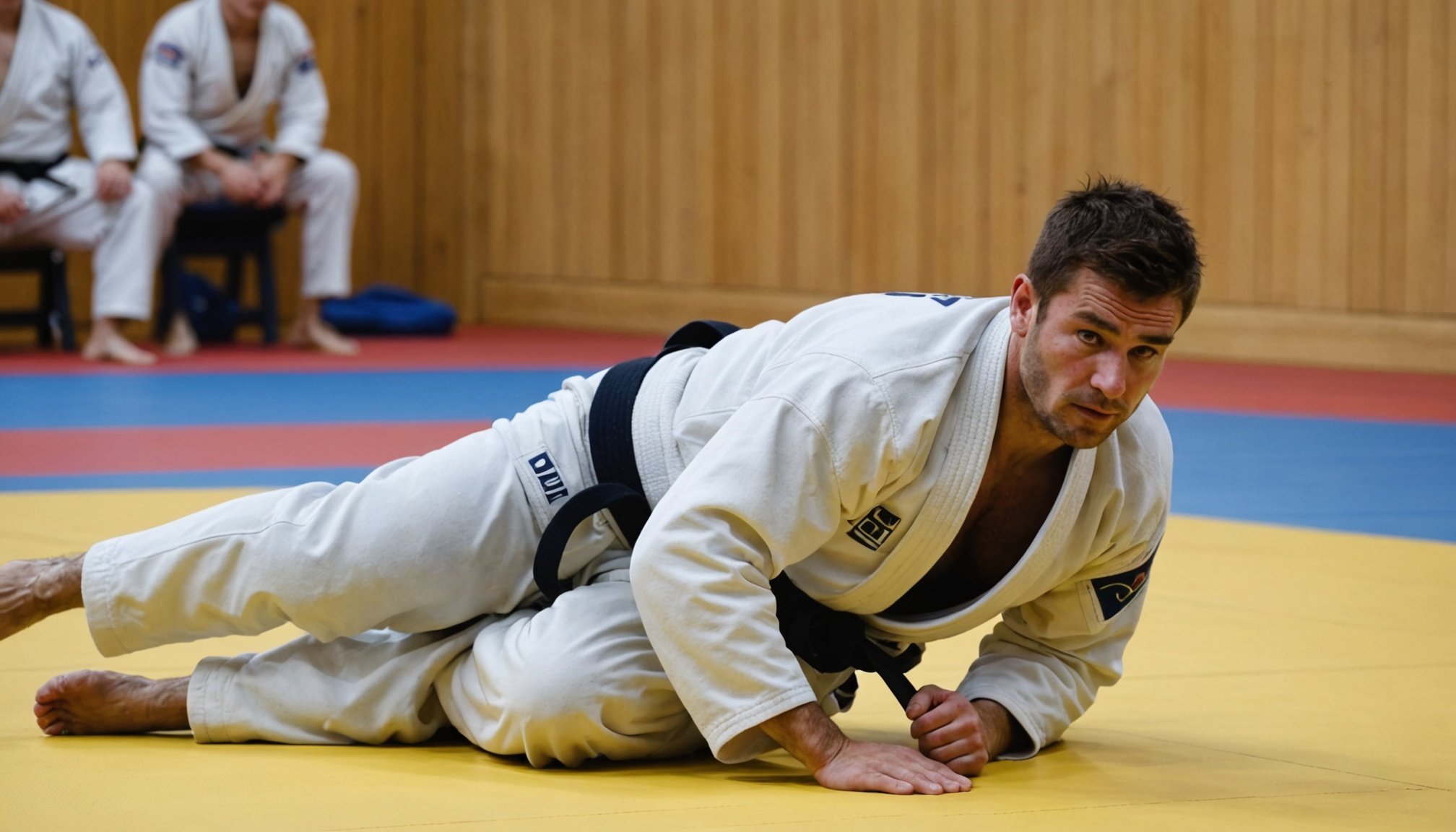Importance of Breakfall Skills in Judo
In the world of Judo, mastering breakfall skills is essential for every athlete. Breakfall techniques, also known as Ukemi, play a pivotal role in helping judokas absorb and distribute force when thrown, significantly reducing the risk of injury. By ensuring athletes land safely and efficiently, these fundamental skills are intrinsic to both practice and competition.
Understanding the relationship between effective breakfall techniques and injury prevention is crucial. A well-executed breakfall dissipates the impact energy over a larger surface area, minimising strain on any one part of the body. This not only prevents injuries like sprains and concussions but also instils confidence in the athletes as they engage in various throws and falls, knowing they can safely recover.
This might interest you : Unlocking peak performance: tailored kickboxing training plans for uk women aligned with menstrual cycle insights
Moreover, breakfall skills enhance athlete performance by allowing for more dynamic and forceful techniques without fear of harm. Judokas who excel in breakfalling can push their limits, trying more advanced Judo techniques with assurance. This diligently hones their overall skill level and boosts their competitiveness.
By ingraining these skills into their routine, judo practitioners lay a strong foundation for their safety and performance. Consistent practice reinforces these techniques, enabling judokas to fully embrace the dynamic nature of this martial art.
Also to discover : Elevate your karate skills: essential dynamic stretching methods for uk practitioners to unlock ultimate flexibility
Effective Techniques for Teaching Breakfalls
Instructing breakfalls effectively requires a blend of teaching strategies tailored for every athlete. For UK judo coaches, understanding that each judoka has a unique learning style is critical. Begin by assessing an athlete’s experience level, then adapt your breakfall instruction accordingly. Whether through visual demonstrations or hands-on guidance, these personalized approaches ensure effective comprehension.
Key strategies involve breaking down the movements into smaller, understandable elements. Coaches should emphasize the importance of body positioning and the role of momentum in judo coaching. Demonstrating the sequence slowly at first, and then progressively increasing speed, can help athletes grasp the concept without feeling overwhelmed.
Avoid common mistakes such as assuming one technique fits all athletes. Recognize individual differences to prevent students from developing improper form or low confidence. Providing personalized feedback during sessions further aids in rectifying mistakes, preventing injury, and boosting performance.
Lastly, enhancing a judoka’s self-assessment skills is essential. Encourage athletes to self-monitor their progress in breakfalls. This empowers them to make adjustments independently, promoting a continuous, self-directed improvement in their technique. Empowering athletes in this aspect of judo ensures long-term success and fosters a deeper connection with the sport.
Drills and Exercises for Mastering Breakfalls
Mastering breakfalls begins with understanding and practising essential drills that allow for performance enhancement and effective tactical training. The development of proper technique can dramatically reduce injury and increase confidence during a fall.
Begin by breaking drills into fundamental stages. Essential drills include rolling backward, forward, and to the sides. Start on soft surfaces and gradually move to harder ones as confidence builds. These drills lay the groundwork for advanced techniques, allowing practitioners to become more adept at breakfalls.
Incorporate these breakfall exercises into regular training. Consistency is key; repeatedly practising these movements will embed them as reflexive actions. Schedule dedicated sessions where exercises such as the “hip fall,” “shoulder roll,” or “side fall” are practised individually, allowing for focus on technique.
As you progress, challenge yourself with varied drills to advance skill mastery. Introduce combinations of falls and integrate them with other movements, simulating real-world scenarios to enhance adaptability. Use resistance bands or partners to add complexity, ensuring these sessions remain engaging and beneficial.
Lastly, regularly assess progression. Video recordings offer invaluable feedback, illustrating areas for improvement and celebrating growth in performance and technical ability. With dedication and practice using these breakfall drills, proficiency and confidence will naturally follow.
Safety Guidelines for Practicing Breakfalls
Understanding safety in judo is fundamental when practicing breakfalls, as it is crucial for injury prevention. Breakfalls, or ukemi, involve techniques designed for safe landing, minimizing impact force. Adherence to training protocols is essential to ensure safety.
Breakfall training should commence with a thorough warm-up to prepare muscles and reduce injury risk. Practicing on appropriate mats is vital. These mats, specifically designed for judo, cushion falls and prevent injuries. The training environment should be well-maintained and free from hazards such as sharp edges or uneven surfaces.
A key element of safety is identifying and mitigating risks. Beginners are advised to start with basic techniques under supervision. Instructors play a critical role in demonstrating proper form and correcting mistakes. Regular feedback helps practitioners refine their techniques and enhances their confidence.
The role of mats cannot be overstated. These specially crafted surfaces absorb and distribute the force of impact, drastically reducing the possibilities of joint injuries or bruises. They provide a controlled environment where practitioners can focus on mastering their breakfalls.
By adhering to these guidelines, judokas can practice effectively and safely, significantly reducing the risk of injuries while enhancing their skill level.
Performance Metrics for Evaluating Breakfall Skills
In the realm of martial arts and physical training, skills assessment is crucial for honing breakfall techniques. Key performance measurement metrics include evaluating reaction time, precision of movement, and impact absorption efficiency. These factors are pivotal in understanding an athlete’s proficiency in executing a breakfall.
Athlete feedback is another integral component. It involves collecting qualitative insights from athletes regarding their personal experiences, challenges, and perceived improvements in executing breakfalls. This subjective feedback can often reveal nuances that quantitative data might miss, such as comfort level and psychological readiness.
Coaches can gather performance data through video analysis and sensor-based tracking. Technologies like motion capture allow for detailed performance measurements, offering insights into movement patterns and areas needing improvement. This data can be instrumental in tailoring coaching methods, focusing on specific areas to enhance the athletes’ skills.
To convey feedback effectively, role-playing scenarios or simulations can be employed, making use of skills assessment insights. This approach ensures that athletes receive practical, actionable advice that encourages improvement. Ultimately, the combination of empirical data and athlete feedback leads to a holistic strategy for developing effective breakfall techniques.
Case Studies of Successful Training Methods
In the world of competitive judo, case studies from UK judo clubs have provided significant insights into the effectiveness of tailored breakfall training. These clubs emphasize breakfalls not only as a method of injury prevention but also as a critical component of performance improvement. Coaching success stories abound, highlighting athletes who have excelled after focused breakfall training.
For instance, one notable example involves a young judoka from a prominent UK club who, through intensive breakfall coaching, enhanced her reaction times and spatial awareness. This adaptation was reflected in her performance improvement, leading to her securing a podium finish at a national event. Such examples underline the importance of individualized training plans that cater to each athlete’s needs.
Competitive judo events offer valuable lessons on breakfalls. Observations reveal that athletes who master this fundamental skill often have a tactical edge, as they can recover more swiftly during matches. The impact of personalized coaching is evident in these scenarios, where athletes not only maximize their physical capabilities but also gain a mental advantage.
These case studies affirm the profound influence of tailored breakfall coaching on overall athlete success, illuminating the path for future training innovations.
Addressing Challenges Faced by UK Judo Coaches
In the UK judo context, coaches encounter several coaching challenges that require innovative solutions. Particularly, teaching breakfalls presents a unique challenge. It’s crucial to ensure athletes learn how to safely fall without injury, a fundamental skill in judo. However, adapting techniques to suit individual learners’ needs can be difficult.
Adaptive coaching becomes essential in this scenario, as it allows coaches to tailor their approaches. By employing diverse teaching styles, coaches can address the diverse learning preferences within their groups. For instance, some learners may benefit from visual demonstrations, while others respond better to verbal instructions or hands-on guidance. Understanding these differences and incorporating them into your methods is key to success.
Support from the community is another crucial aspect of overcoming these challenges. Engaging with local judo associations and participating in workshops can provide valuable insights and techniques from peers who have faced similar hurdles. A strong community offers not only resources but also the morale boost necessary for continuous improvement.
By embracing adaptive strategies and leveraging community support, UK judo coaches can navigate these challenges effectively, ensuring they deliver the best guidance possible, which in turn encourages athletes to thrive.











